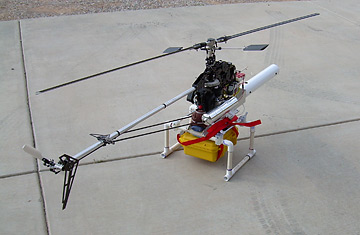
This helicopter provides computing and electrical support to a sensor node developed to detect structural changes in bridges.
Almost a week after a Minneapolis bridge unexpectedly collapsed, National Transportation Safety Board investigators are struggling to determine the catastrophe's cause. They are considering factors such as wear and tear, weather, or the weight of a construction project taking place at the time that closed half of the bridge's eight lanes. But within the next decade, engineers hope to have technology in place that will allow the bridges themselves to notify officials when something is out of whack, giving governments the opportunity to fix problems before a disaster occurs.
A team at the Los Alamos National Laboratory is working with the University of California at San Diego to design and power small sensors to place on bridges — or on any piece of infrastructure for that matter — that would measure structural problems like strain, deflection, cracks, corrosion or the loosening of bolts, says Chuck Farrar, a civil engineer at the Los Alamos lab. Once the sensors identify a hazardous change in the structure's vitals, such as its dimensions or temperature, they would transmit the information to a computer, which would analyze the data to figure out what went wrong.
The idea is to partner with state departments of transportation or highway patrols to use the technology, Farrar says, because they could control the feedback, determining how often they want a reading of the sensors — once a minute, once a month, once a year. The sensors could eventually replace the jobs of inspectors altogether. Farrar argues that it would be more cost-effective in the long run because states could focus on sending a repair crew only when they already know there's a problem (and exactly where and what it is). "It would lead to much more continuous monitoring of bridges, as opposed to the limited monitoring done right now," says Farrar. Most states have to inspect their bridges only every two years to comply with federal mandates. The Minneapolis bridge was inspected last year, and there was another inspection planned for the fall. The last inspection found no immediate structural flaws in the bridge, Minnesota Gov. Tim Pawlenty said in a news conference after the collapse.
The chief problem with the sensor technology is how to find an inexpensive way of transmitting the sensors' data to computers. Sensors currently rely on batteries that often need to be replaced, and they require a fair amount of bulky hardware. "Right now, it wouldn't be a cost-effective way [to monitor changes] on structures like bridges," Farrar says. So his team is testing small, remote-controlled helicopters that would send a pulse to provide power to the sensor, take a reading and send it back to the helicopter's computer and then transmit the data to officials.
Chris Goggin, who heads his own research and engineering company in Wilmington, N.C., is working on a different method of transmission; a radiowave-powered switch that can wirelessly control small devices such as locators or sensors. Goggin, a semi-finalist for the History Channel's annual Modern Marvels Invent Now Challenge this year, says state officials could get data from the sensors directly at the push of a button and a radio signal would act as a transmitter, putting the bridge's sensor information into an e-mail sent straight to their inbox. "You wouldn't need helicopters or lights for solar power. That's just crazy and costly," Goggin says. "This would be a permanent part of the bridge and it wouldn't have to be replaced, maintained or touched." Goggin's wireless device, which was recently patented and is the size of a pencil eraser, would attach to each sensor placed on a structure for a cost of 50 cents each. While Farrar says there are several ways to power the sensors and it's still "early on in the game" to say which is best, Goggin says that researchers could use his invention, which has been tested and patented, with the types of sensors already available and install it tomorrow. "This is ready now," he says.
Other experts say it's not that simple. Paul Maltseff, an intellectual property legal counsel for Intermec Inc., a technology company that did an independent review of Goggin's invention, says the device is "a phenomenon of interest," but that more research and development needs to be done on both sensors and the wireless switch before the technology is effective.
Farrar agrees and says the Los Alamos lab has been testing sensors on bridges for the last 10 years, but that the technology is not yet ready for implementation. His team is about a year and a half into a four-year project to test and develop this technology, and it will be tried out on a New Mexico bridge at the end of the month. He expects that after the project is completed, it will still be a year or more before these new sensors for infrastructure become commercially available.
The biggest obstacle so far is finding funding for their research. "It's a big investment over a long period of time. What we need is a person in a leadership position saying this is worthwhile," says Farrar. The collapse of the Minneapolis bridge last week, alas, may be just the spur that he's looking for.
